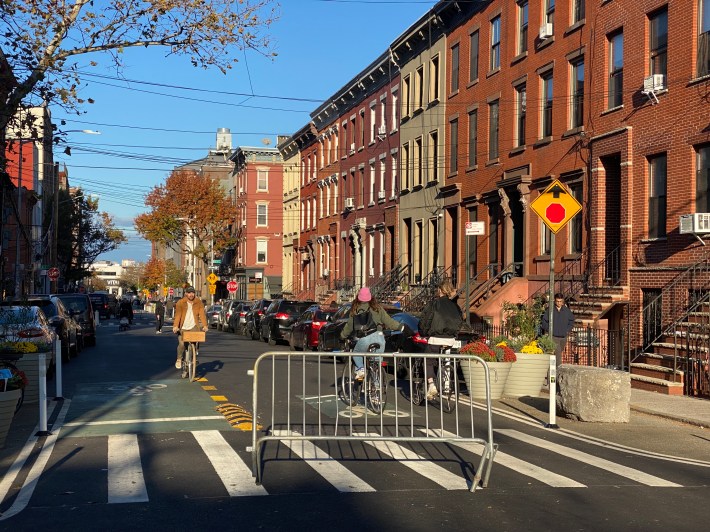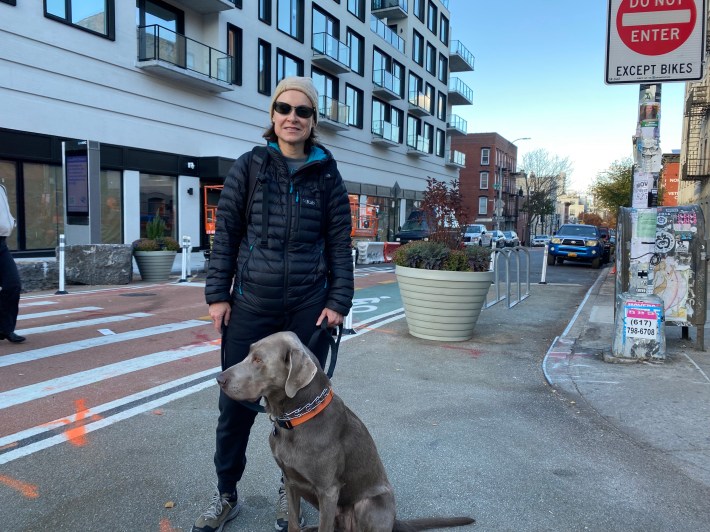The city has converted the Berry Street open street into a permanent two-way bike boulevard, using simple redesigns to reduce traffic on the nearly mile-long north Brooklyn strip and turning it into a much-needed extension of public space.
The Department of Transportation revamped Berry, between Broadway and N. 12th Street, by flipping the one-way traffic at three pairs of blocks, adding coral-colored paint to some intersections, and extending curbs at every intersection for better visibility and extra space — an increasingly popular street treatment known as daylighting.
The overhauls, especially the flipped traffic direction, dramatically reduced the number of cars using Berry and should serve as a model for roads across the Big Apple, said one local advocate.
“Ultimately all of those physical things are what every local street in this city should have,” said Brent Bovenzi, a volunteer with the North Brooklyn Open Streets Community Coalition, which launched Berry Street and several other car-free corridors during the pandemic.
The agency has done or is in the process of doing similar redesigns at other pandemic-era open streets, including 34th Avenue in Queens, W. 22nd Street in Manhattan, and the stalled Underhill Avenue bike boulevard.

But this project was not guaranteed in Williamsburg and Greenpoint, where the battle for safe streets has heated up in recent years and some locals have managed to derail redesigns.
An opponent of the open streets program assaulted one local volunteer in 2021, and later another vigilante stole a bunch of the street barriers under the cover of darkness, loaded them into an Amazon-branded van and dumped them into the Newtown Creek.
The Adams administration this year intervened repeatedly in its own DOT's efforts to improve safety on deadly McGuinness Boulevard, first halting and then watering down a road diet with bike lanes after protest from powerful local business interests led by the film production studio Broadway Stages.
Berry is one of the longest pandemic-era projects that reclaimed space from cars, and DOT presented a plan last year to implement permanent changes to the street, but those faced delays due to “supply chain” issues and didn’t become a reality until more than a year later.
At each of the intersection of the 19 blocks of Berry between the Williamsburg Bridge and McCarren Park there are painted curb extensions at the corners with harder additions like bike corrals and boulders to keep them free of cars and provide more visibility, while also creating new slices of public space.
"When the boulders came in, someone was sitting on it within an hour, so there’s clearly a demand for this stuff," Bovenzi said.
The street, which used to be northbound only, has two-way markings for cyclists. Before the redesign, DOT's street activity sensors revealed that 20 percent of bike riders were already going southbound against the direction of traffic when it became an open street, prompting the agency to formalize the street into a two-way corridor for the two-wheelers.
For cars, the speed limit is lower at five miles per hour. Berry is mostly northbound, but DOT has flipped the direction for two blocks each north of Broadway, Grand Street, and N. Fifth Street. That simple change has "naturally" reduced car traffic to local access, according to the agency, and there were very few cars on the road on a recent visit compared to busy parallel streets like Bedford Avenue.
"I don’t think you have a GPS telling people to shoot down Berry," said Bovenzi.

DOT painted the intersections at the reversed blocks in a new kind of coral shade. The off-red markings are also at intersections without traffic lights and stop signs, and serve to give drivers a visual cue.
“The idea is that it’s a way to communicate at some of the busier intersections, ‘Hey, there is something different going on here,’” said Bovenzi. “We’re still seeing how that plays out.”
The open street remains in effect 8 a.m. – 8 p.m. daily and its barricades remain up because they’re still essential to keeping drivers out, said Bovenzi. His coalition is pushing DOT to expand the redesigns to make the corridor more welcoming to pedestrians, some of whom were still unsure if they were allowed on the road, he said.
“The barriers are still absolutely necessary to still discourage drivers from going down the street and to communicate to pedestrians that they’re allowed to walk down that street and are equal users,” the Brooklynite said.

On the conversion of the one-block W. 22nd Open Street, the removal of barriers led to drivers dominating that stretch of road once again, with few people feeling safe enough to walk on that block as they used to during the pandemic traffic closure.
DOT installed loading zones at the end of each block, but Bovenzi said that their signs were not clear enough and looked too similar to regular alternate-side-parking signs, with delivery trucks still parking illegally.
"It’s still a tiny sign, the street sweeping sign," he said.
There are some “Share the Road” signs and cars are still allowed on Berry, but they’re supposed to yield to pedestrians, along with more prominent “Do Not Enter” signs at blocks where the traffic direction changes.
On recent Saturday, the area around Berry was abuzz with foot traffic, and locals said the changes made a difference, even if they still took some getting used to.
“I like the design; it did lower the traffic,” said David Burgos. “I was a little confused by the two bike lanes initially, but now I know.”

However, he said that drivers were running more red lights to get past the new open space.
“I feel like cars are actually running the lights even more,” Burgos said.
Another resident who was walking her dog said it was a huge boon by giving more space for pedestrians in a busy neighborhood.
“It’s just desperately needed,” said Camille Renshaw, as she walked her Labrador Atticus, 5, on Berry. “I love anything that they can do to turn this into a more pedestrian throughway.”

Bovenzi proposed additional design interventions mid-block, as DOT has done by starting to install markings and planters in the middle of the road on Underhill Avenue, along with better daylighting on all four corners of each intersection of Berry.
There are still two continuous five-block stretches where traffic doesn't flip, and street planners could reduce through traffic even more if they reversed some more sections of Berry, according to the Brooklynite.
DOT should create a continuous bike and pedestrian-priority corridor from Berry Street around McCarren Park, Bovenzi said, by extending it north where Berry turns into Nassau Avenue — which used to have an open street — connecting it to the recently completed pedestrian plaza at Bankers Anchor.
The city must also open a pedestrian plaza on the redundant offshoot of Bedford Avenue between Nassau and Manhattan Avenues, which local advocates call Bedford Slip, the advocate added.
DOT spokesperson Mona Bruno said the agency will continue to monitor the bike boulevard and “make adjustments as needed."
For another great look at the Berry Street bike boulevard, check out a recent video by Streetfilms.






